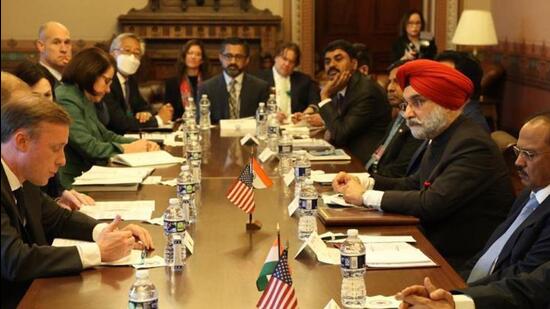The United States and India launched their initiative on critical and emerging technologies earlier this month (ICET). If realised, the promise of this initiative could have a transformative impact on India-US relations. National Security Adviser Ajit Doval stated on the eve of the dialogue that the main need was to convert intentions and ideas into deliverables. This is usually where a slip occurs.

Background
- Background Information on India’s Attempts at US Technology Parallels: Since the 1960s, India has made numerous attempts to join the American technological bandwagon.
- Failed due to mismatch: However, all of them have failed, owing to a mismatch between the two countries on the goals for which they collaborated.
- Unlike previous iterations, the ICET comes at a time when India, too, has developed technological and managerial capacities and is emerging as a major economic power.
What is the Critical and Emerging Technologies Initiative (ICET)?
- PM Modi and President Joe Biden launched: In May 2022, Indian Prime Minister Narendra Modi and US President Joe Biden launched the ICET initiative.
- The goal is to elevate and expand the Indo-US partnership through strategic technology partnerships and defence industrial cooperation between the two countries’ governments, businesses, and academic institutions.
- PMO and White House directly monitor: The ICET will be overseen and directed by the Prime Minister’s Office in Delhi and the White House in Washington.
- Strengthening innovation ecosystems, defence innovation and technology cooperation, resilient semiconductor supply chains, space, STEM talent, and next generation telecom are the six co-development and co-production focus areas.
So far, American assistance has been provided.
- Significant contribution to India’s development efforts and technological capability: The Cold War was a major driver of the process, persuading the US to provide broad assistance to India in a variety of areas. While the Soviet Union rose to prominence in industries such as steel, heavy electricals, petroleum, and mining, the United States concentrated on modernising engineering and management education, science and technology (S&T), and agriculture.
- Nuclear energy cooperation: The United States assisted in the construction of India’s first reactors for research and power. An entire generation of Indian nuclear scientists was trained in the United States, including some who later assisted in the development of nuclear weapons.
- The massive aid provided by the US to modernise Indian education, particularly engineering and management, should have resulted in a growing industrial sector, but the Indian economy stalled in the 1960s, and India ended up with a system in which IIT and IIM graduates benefited the US economy.
- Agriculture aid: The one area where India did receive long-term and significant benefits was agriculture, where American science and technology helped trigger the Green Revolution and end an era of food scarcity.
- Science and Technology Initiative of Gandhi and Reagan: The Gandhi-Reagan Science and Technology Initiative resulted in the 1984 India-US Memorandum of Understanding on sensitive technologies, commodities, and information.
- New American willingness to promote Indian science and technology and the defence industry: In 1987, the United States agreed to assist India’s Light Combat Aircraft (Tejas) programme and allowed the sale of front-line GE 404 engines to India.
Current Situation
- India has steadily advanced in its status as a US ally, purchasing billions of dollars in US weapons and systems.
- It is now classified as a Major Defense Partner, rather than a Major Non-NATO Ally, a far more useful designation that Pakistan retains.
- The path has not been without difficulties, as evidenced by the pressures India has faced as a result of CAATSA and its oil trade with Russia.
Ambitious goals
- Excellent deal for India: The ICET has established a number of ambitious goals that will have a significant impact on India. Some are aspirational, while others are political. Some are exaggerated, such as the belief that the United States will assist India in developing advanced jet engines.
- Jet engine licencing: For the time being, the only option is to licence manufacture GE-404/414 engines for the LCA. This is not a new phenomenon. However, cutting-edge jet engines are the United States’ crown jewels, which it will not give up.
@the end
“This is a golden opportunity for India,” the finance minister said in an interview after presenting the Union Budget. We really shouldn’t miss the bus this time.” The remark is more applicable to the ICET’s potential as a technology and industrialisation bus.
Source: https://www.livemint.com/news/world/icet-has-potential-to-take-us-india-ties-to-next-level-arun-singh-11675770025575.html
